1999 SUZUKI GRAND VITARA block
[x] Cancel search: blockPage 12 of 656
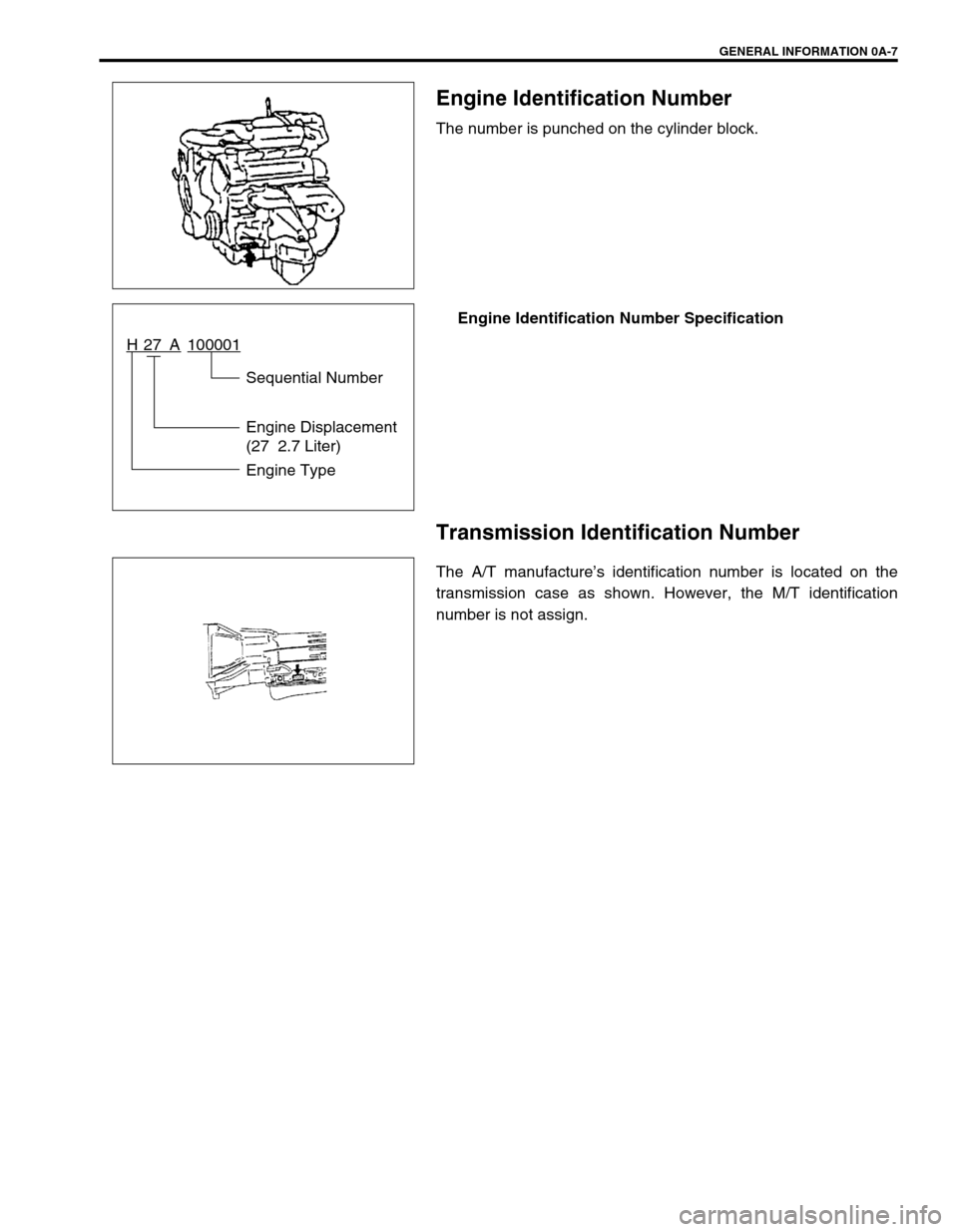
GENERAL INFORMATION 0A-7
Engine Identification Number
The number is punched on the cylinder block.
Engine Identification Number Specification
Transmission Identification Number
The A/T manufacture’s identification number is located on the
transmission case as shown. However, the M/T identification
number is not assign.
27 H A 100001
Sequential Number
Engine Displacement
(27 2.7 Liter)
Engine Type
Page 46 of 656
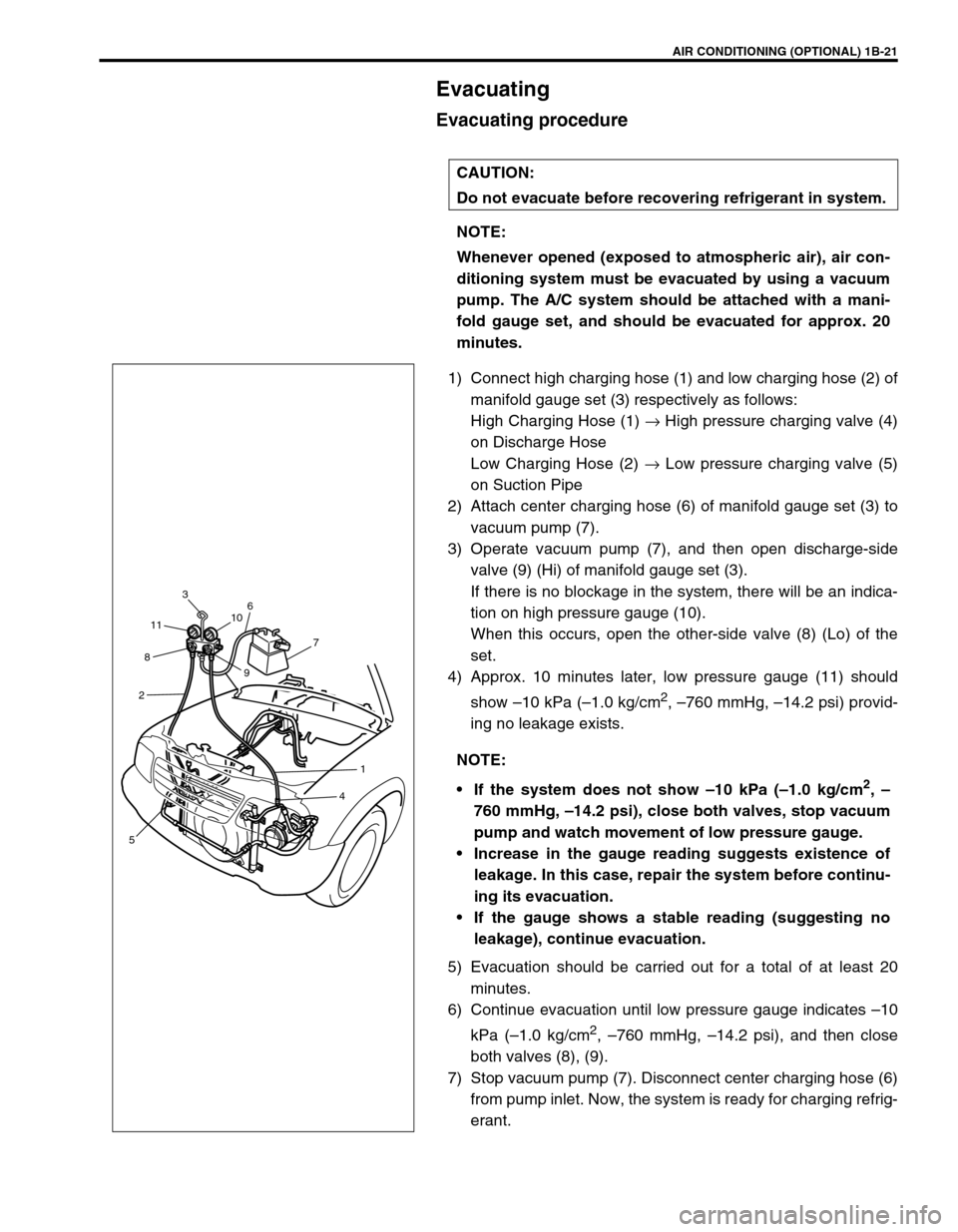
AIR CONDITIONING (OPTIONAL) 1B-21
Evacuating
Evacuating procedure
1) Connect high charging hose (1) and low charging hose (2) of
manifold gauge set (3) respectively as follows:
High Charging Hose (1) → High pressure charging valve (4)
on Discharge Hose
Low Charging Hose (2) → Low pressure charging valve (5)
on Suction Pipe
2) Attach center charging hose (6) of manifold gauge set (3) to
vacuum pump (7).
3) Operate vacuum pump (7), and then open discharge-side
valve (9) (Hi) of manifold gauge set (3).
If there is no blockage in the system, there will be an indica-
tion on high pressure gauge (10).
When this occurs, open the other-side valve (8) (Lo) of the
set.
4) Approx. 10 minutes later, low pressure gauge (11) should
show –10 kPa (–1.0 kg/cm
2, –760 mmHg, –14.2 psi) provid-
ing no leakage exists.
5) Evacuation should be carried out for a total of at least 20
minutes.
6) Continue evacuation until low pressure gauge indicates –10
kPa (–1.0 kg/cm
2, –760 mmHg, –14.2 psi), and then close
both valves (8), (9).
7) Stop vacuum pump (7). Disconnect center charging hose (6)
from pump inlet. Now, the system is ready for charging refrig-
erant. CAUTION:
Do not evacuate before recovering refrigerant in system.
NOTE:
Whenever opened (exposed to atmospheric air), air con-
ditioning system must be evacuated by using a vacuum
pump. The A/C system should be attached with a mani-
fold gauge set, and should be evacuated for approx. 20
minutes.
NOTE:
If the system does not show –10 kPa (–1.0 kg/cm
2, –
760 mmHg, –14.2 psi), close both valves, stop vacuum
pump and watch movement of low pressure gauge.
Increase in the gauge reading suggests existence of
leakage. In this case, repair the system before continu-
ing its evacuation.
If the gauge shows a stable reading (suggesting no
leakage), continue evacuation.
3
11
8
2106
7
9
1
4
5
Page 166 of 656

ENGINE GENERAL INFORMATION AND DIAGNOSIS (H27 ENGINE) 6-1-5
Fuel Pressure Relief Procedure
After making sure that engine is cold, relief fuel pressure as fol-
lows.
1) Place transmission gear shift lever in “Neutral” (shift selector
lever to “P” range for A/T vehicle), set parking brake, and
block drive wheels.
2) Remove fuel pump relay (1) from its connector.
3) Remove fuel filler cap to release fuel vapor pressure in fuel
tank and then reinstall it.
4) Start engine and run it till it stops for lack of fuel. Repeat
cranking engine 2 – 3 times of about 3 seconds each time to
dissipate fuel pressure in lines. Fuel connections are now
safe for servicing.
5) Upon completion of servicing, install fuel pump relay to relay
box.
Fuel Leakage Check Procedure
After performing any service on fuel system, check to make sure
that there are no fuel leakages as follows.
1) Turn ON ignition switch for 3 seconds (to operate fuel pump)
and then turn it OFF.
Repeat this (ON and OFF) 3 or 4 times and apply fuel pres-
sure to fuel line (till fuel pressure is felt by hand placed on
fuel return hose).
2) In this state, check to see that there are no fuel leakages
from any part of fuel system. CAUTION:
This work must not be done when engine is hot. If done
so, it may cause adverse effect to catalyst.
[A] : Left hand steering vehicle
[B] : Right hand steering vehicle
2. Fuse box
Page 281 of 656
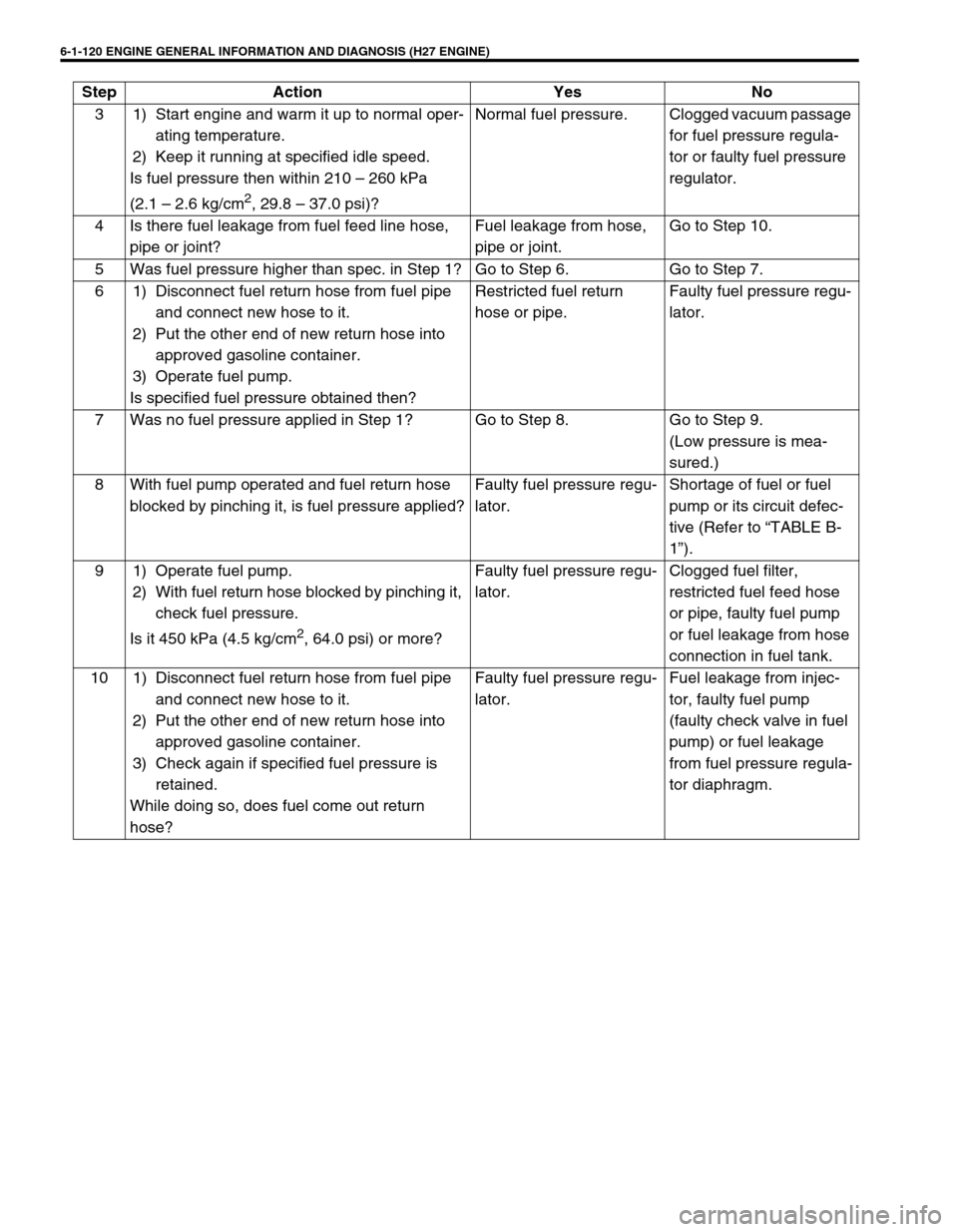
6-1-120 ENGINE GENERAL INFORMATION AND DIAGNOSIS (H27 ENGINE)
3 1) Start engine and warm it up to normal oper-
ating temperature.
2) Keep it running at specified idle speed.
Is fuel pressure then within 210 – 260 kPa
(2.1 – 2.6 kg/cm
2, 29.8 – 37.0 psi)?Normal fuel pressure. Clogged vacuum passage
for fuel pressure regula-
tor or faulty fuel pressure
regulator.
4 Is there fuel leakage from fuel feed line hose,
pipe or joint?Fuel leakage from hose,
pipe or joint.Go to Step 10.
5 Was fuel pressure higher than spec. in Step 1? Go to Step 6. Go to Step 7.
6 1) Disconnect fuel return hose from fuel pipe
and connect new hose to it.
2) Put the other end of new return hose into
approved gasoline container.
3) Operate fuel pump.
Is specified fuel pressure obtained then?Restricted fuel return
hose or pipe.Faulty fuel pressure regu-
lator.
7 Was no fuel pressure applied in Step 1? Go to Step 8. Go to Step 9.
(Low pressure is mea-
sured.)
8 With fuel pump operated and fuel return hose
blocked by pinching it, is fuel pressure applied?Faulty fuel pressure regu-
lator.Shortage of fuel or fuel
pump or its circuit defec-
tive (Refer to “TABLE B-
1”).
9 1) Operate fuel pump.
2) With fuel return hose blocked by pinching it,
check fuel pressure.
Is it 450 kPa (4.5 kg/cm
2, 64.0 psi) or more?Faulty fuel pressure regu-
lator.Clogged fuel filter,
restricted fuel feed hose
or pipe, faulty fuel pump
or fuel leakage from hose
connection in fuel tank.
10 1) Disconnect fuel return hose from fuel pipe
and connect new hose to it.
2) Put the other end of new return hose into
approved gasoline container.
3) Check again if specified fuel pressure is
retained.
While doing so, does fuel come out return
hose?Faulty fuel pressure regu-
lator.Fuel leakage from injec-
tor, faulty fuel pump
(faulty check valve in fuel
pump) or fuel leakage
from fuel pressure regula-
tor diaphragm. Step Action Yes No
Page 288 of 656

ENGINE MECHANICAL (H27 ENGINE) 6A2-1
6A2
SECTION 6A2
ENGINE MECHANICAL (H27 ENGINE)
CONTENTS
On-Vehicle Service........................................6A2-2
Throttle Body and Intake Manifold .............. 6A2-2
Exhaust Manifold ......................................... 6A2-9
LH (No.1) Bank 2nd Timing Chain
and Chain Tensioner ................................. 6A2-13
Camshaft and Valve Lash Adjuster ........... 6A2-14
Valves and Cylinder Heads ....................... 6A2-17
Piston, Piston Rings, Connecting Rodsand Cylinders ............................................ 6A2-21
Unit Repair Overhaul .................................. 6A2-26
Engine Assembly ...................................... 6A2-26
Main Bearings, Crankshaft
and Cylinder Block .................................... 6A2-30
Special Tool ................................................. 6A2-36
WARNING:
For vehicles equipped with Supplemental Restraint (Air Bag) System:
Service on and around the air bag system components or wiring must be performed only by an
authorized SUZUKI dealer. Refer to “Air Bag System Components and Wiring Location View” under
“General Description” in air bag system section in order to confirm whether you are performing ser-
vice on or near the air bag system components or wiring. Please observe all WARNINGS and “Ser-
vice Precautions” under “On-Vehicle Service” in air bag system section before performing service
on or around the air bag system components or wiring. Failure to follow WARNINGS could result in
unintentional activation of the system or could render the system inoperative. Either of these two
conditions may result in severe injury.
Technical service work must be started at least 90 seconds after the ignition switch is turned to the
“LOCK” position and the negative cable is disconnected from the battery. Otherwise, the system
may be activated by reserve energy in the Sensing and Diagnostic Module (SDM).
NOTE:
For the descriptions (items) not found in this section, refer to the same section of service manual
mentioned in the FOREWORD of this manual.
Whether following systems (parts) are used in the particular vehicle or not depends on specifica-
tions. Be sure to bear this in mind when performing service work.
–EGR valve
–Warm up three way catalytic converter
–Heated oxygen sensor(s)
–Three way catalytic converter
–CKP sensor
–MAP sensor
Page 297 of 656
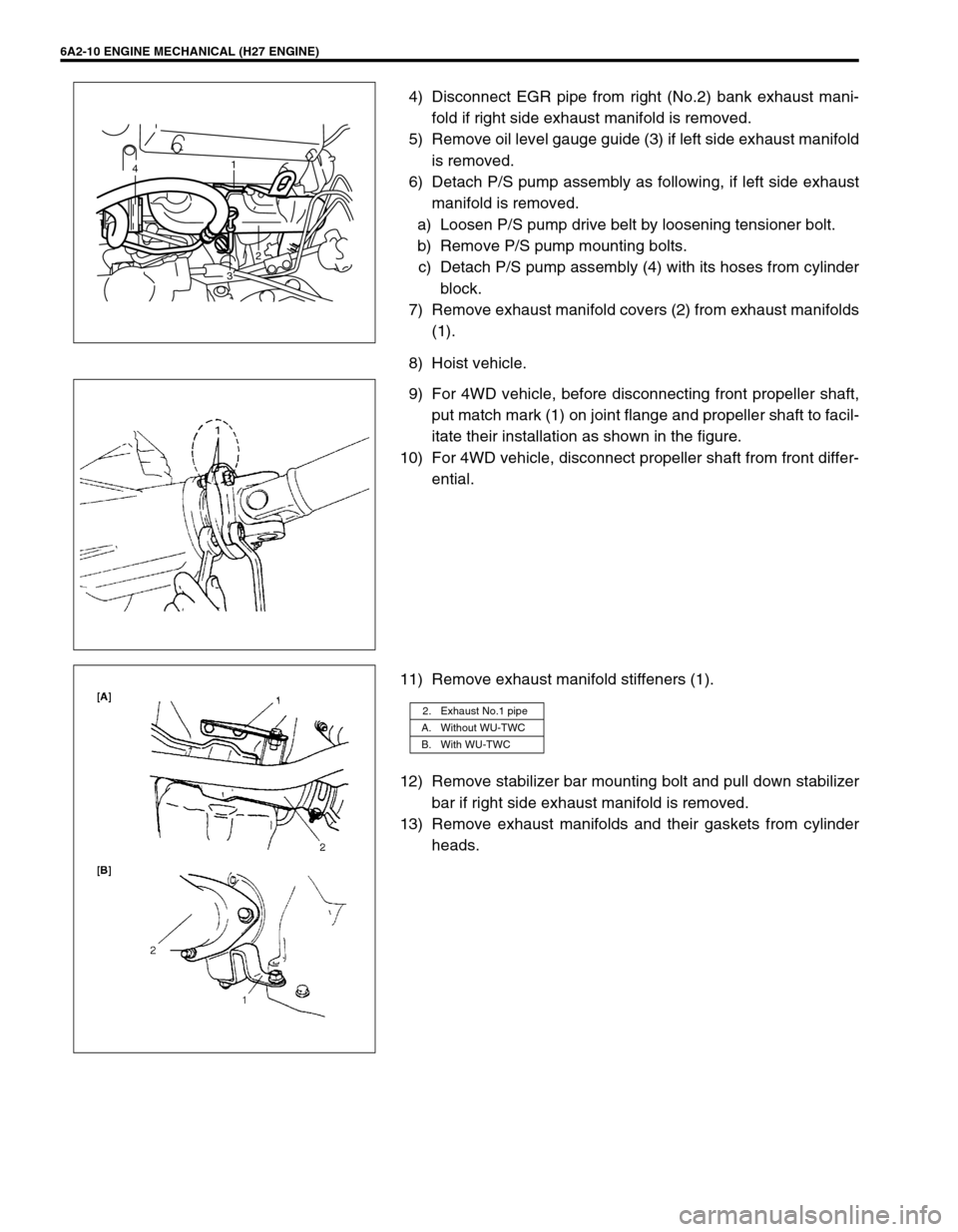
6A2-10 ENGINE MECHANICAL (H27 ENGINE)
4) Disconnect EGR pipe from right (No.2) bank exhaust mani-
fold if right side exhaust manifold is removed.
5) Remove oil level gauge guide (3) if left side exhaust manifold
is removed.
6) Detach P/S pump assembly as following, if left side exhaust
manifold is removed.
a) Loosen P/S pump drive belt by loosening tensioner bolt.
b) Remove P/S pump mounting bolts.
c) Detach P/S pump assembly (4) with its hoses from cylinder
block.
7) Remove exhaust manifold covers (2) from exhaust manifolds
(1).
8) Hoist vehicle.
9) For 4WD vehicle, before disconnecting front propeller shaft,
put match mark (1) on joint flange and propeller shaft to facil-
itate their installation as shown in the figure.
10) For 4WD vehicle, disconnect propeller shaft from front differ-
ential.
11) Remove exhaust manifold stiffeners (1).
12) Remove stabilizer bar mounting bolt and pull down stabilizer
bar if right side exhaust manifold is removed.
13) Remove exhaust manifolds and their gaskets from cylinder
heads.
1
4
32
2. Exhaust No.1 pipe
A. Without WU-TWC
B. With WU-TWC
Page 302 of 656
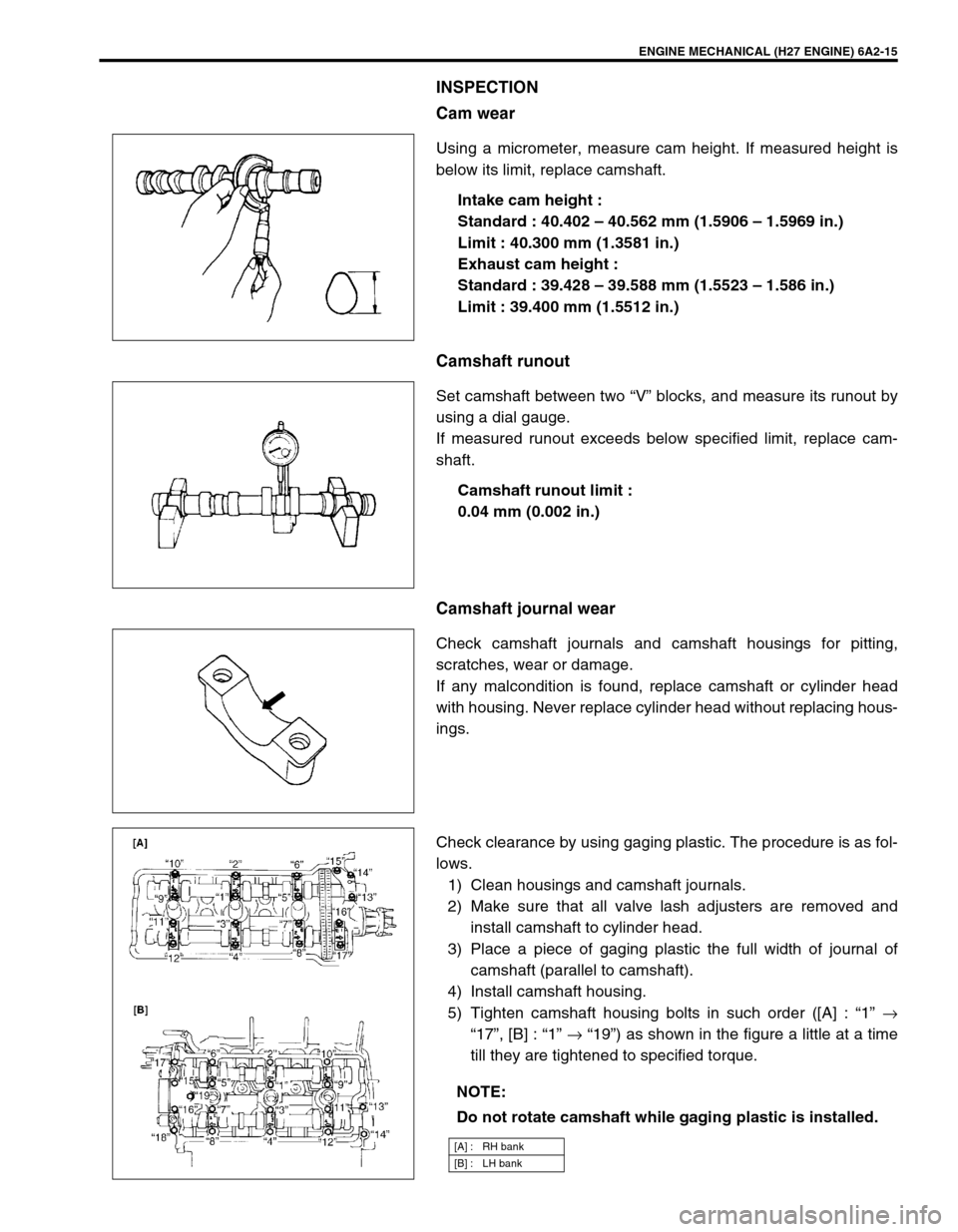
ENGINE MECHANICAL (H27 ENGINE) 6A2-15
INSPECTION
Cam wear
Using a micrometer, measure cam height. If measured height is
below its limit, replace camshaft.
Intake cam height :
Standard : 40.402 – 40.562 mm (1.5906 – 1.5969 in.)
Limit : 40.300 mm (1.3581 in.)
Exhaust cam height :
Standard : 39.428 – 39.588 mm (1.5523 – 1.586 in.)
Limit : 39.400 mm (1.5512 in.)
Camshaft runout
Set camshaft between two “V” blocks, and measure its runout by
using a dial gauge.
If measured runout exceeds below specified limit, replace cam-
shaft.
Camshaft runout limit :
0.04 mm (0.002 in.)
Camshaft journal wear
Check camshaft journals and camshaft housings for pitting,
scratches, wear or damage.
If any malcondition is found, replace camshaft or cylinder head
with housing. Never replace cylinder head without replacing hous-
ings.
Check clearance by using gaging plastic. The procedure is as fol-
lows.
1) Clean housings and camshaft journals.
2) Make sure that all valve lash adjusters are removed and
install camshaft to cylinder head.
3) Place a piece of gaging plastic the full width of journal of
camshaft (parallel to camshaft).
4) Install camshaft housing.
5) Tighten camshaft housing bolts in such order ([A] : “1” →
“17”, [B] : “1” → “19”) as shown in the figure a little at a time
till they are tightened to specified torque.
NOTE:
Do not rotate camshaft while gaging plastic is installed.
[A] : RH bank
[B] : LH bank
Page 304 of 656
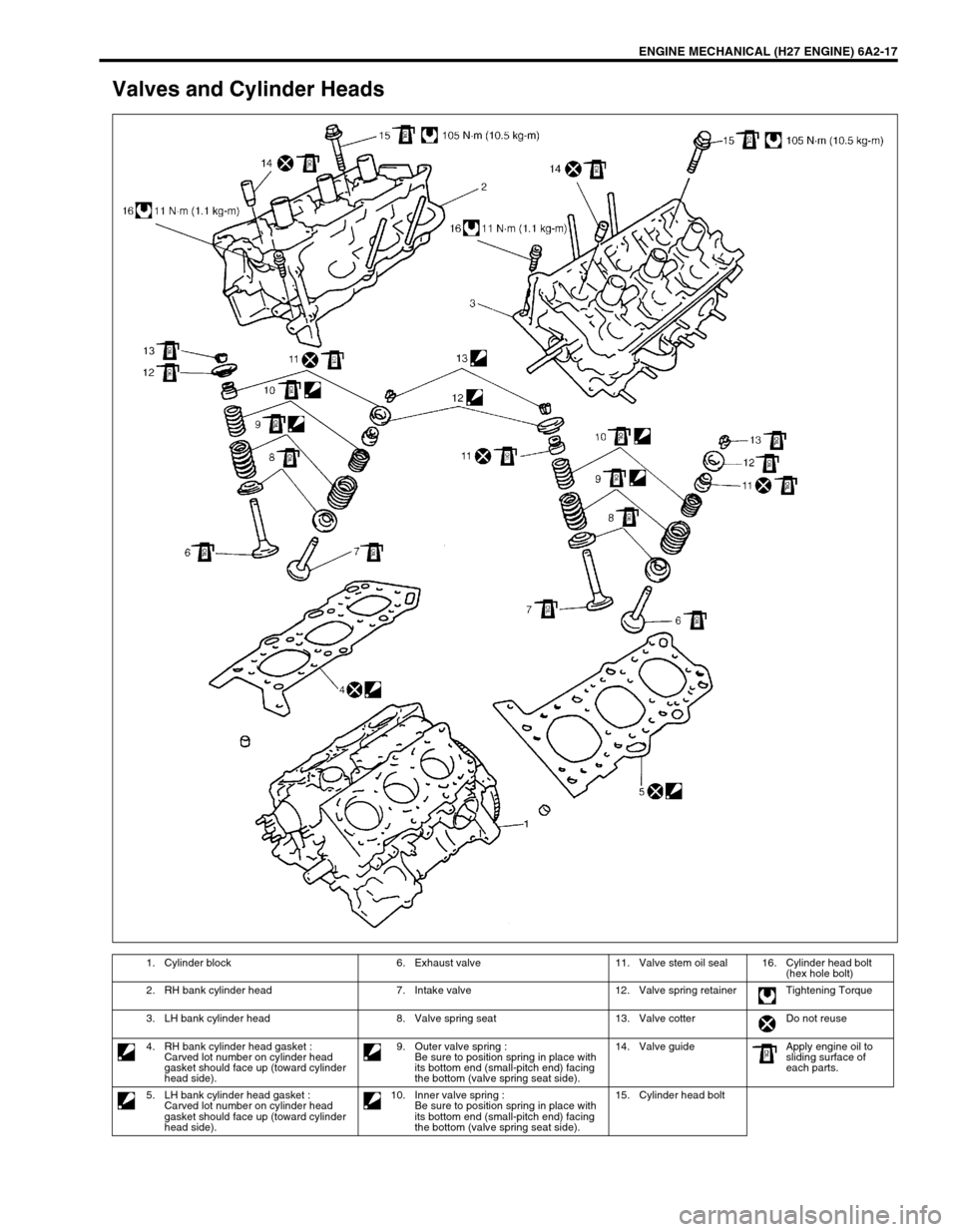
ENGINE MECHANICAL (H27 ENGINE) 6A2-17
Valves and Cylinder Heads
1. Cylinder block 6. Exhaust valve 11. Valve stem oil seal 16. Cylinder head bolt
(hex hole bolt)
2. RH bank cylinder head 7. Intake valve 12. Valve spring retainer Tightening Torque
3. LH bank cylinder head 8. Valve spring seat 13. Valve cotter Do not reuse
4. RH bank cylinder head gasket :
Carved lot number on cylinder head
gasket should face up (toward cylinder
head side).9. Outer valve spring :
Be sure to position spring in place with
its bottom end (small-pitch end) facing
the bottom (valve spring seat side).14. Valve guide Apply engine oil to
sliding surface of
each parts.
5. LH bank cylinder head gasket :
Carved lot number on cylinder head
gasket should face up (toward cylinder
head side).10. Inner valve spring :
Be sure to position spring in place with
its bottom end (small-pitch end) facing
the bottom (valve spring seat side).15. Cylinder head bolt